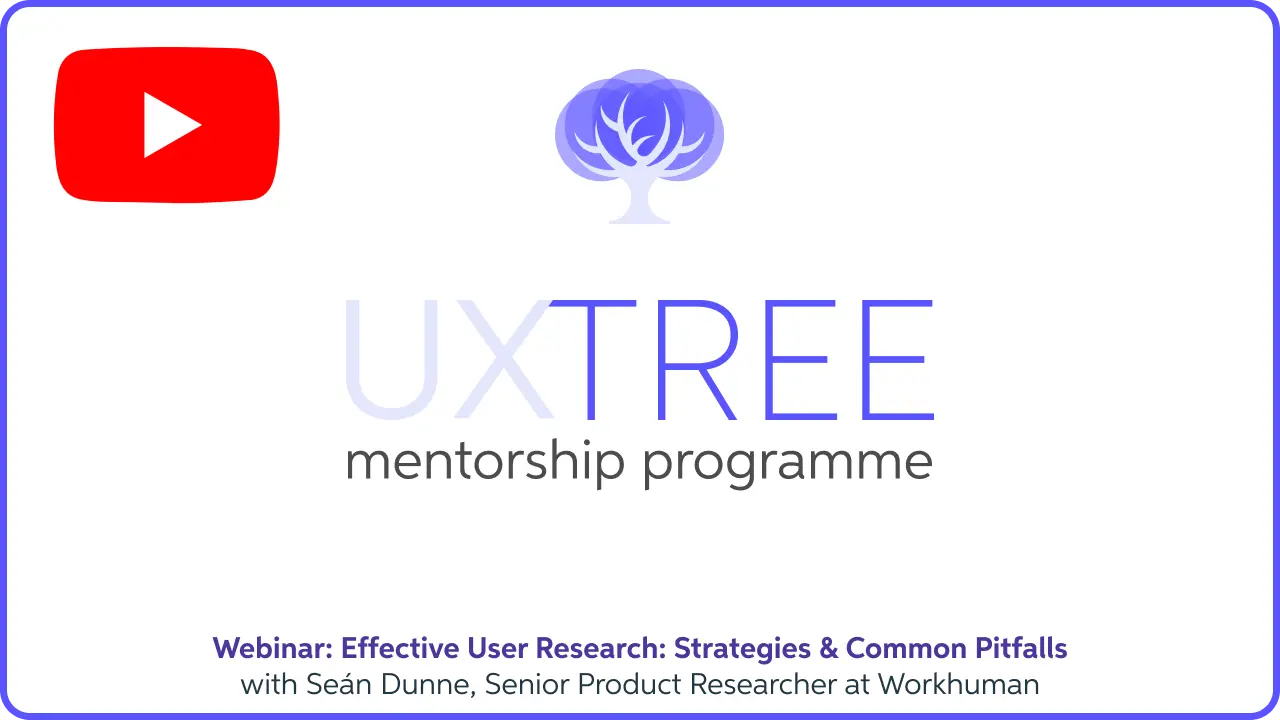Webinar: Effective User Research: Strategies & Common Pitfalls

User research is the backbone of creating products that truly resonate with users. In a recent webinar hosted by UX Tree, Seán Dunne, a Senior Product Researcher at Workhuman, shared invaluable insights into the strategies, pitfalls, and best practices of effective user research. With over seven years of experience in UX research, Seán has worked on a variety of products, from e-commerce stores to performance management tools, and his expertise shone through in this engaging session.
Here’s a breakdown of the key points from the webinar, packed with advice for anyone looking to elevate their user research game.
Why User Research Matters
Seán kicked off the session by emphasising the importance of user research in product development. Here’s why it’s non-negotiable:
- Promotes User-Centred Design
UX research ensures that the design process revolves around the goals, needs, and pain points of users, leading to more relevant and usable products. - Informs Decision-Making
It reduces risks by providing data-driven insights, preventing costly mistakes down the line. - Enhances User Satisfaction
Addressing user pain points and aligning with their expectations leads to better experiences and higher satisfaction.
Seán highlighted the infamous example of Google Glass, a product that failed due to a lack of user-centred research. Despite its innovative technology, Google Glass suffered from low adoption and retention rates because it didn’t solve a clear user problem, had privacy concerns, and lacked social acceptance. This case study underscores the importance of understanding not just functional goals but also emotional and social goals when designing products.
The False Consensus Effect: A Key Pitfall
One of the most fascinating insights Seán shared was the concept of the false consensus effect—the tendency to overestimate how much others share our beliefs and behaviours. This cognitive bias can lead designers to project their own preferences onto users, resulting in products that miss the mark.
To combat this, Seán stressed the importance of empathy and objective insights. By understanding how users think, feel, and behave, we can avoid designing for ourselves and instead create solutions that truly meet user needs.
Choosing the Right Research Methodology
Selecting the appropriate research method is crucial for answering your research questions effectively. Seán outlined a step-by-step approach:
- Identify the User Problem
What are you trying to solve? This could come from past research, competitive analysis, or assumptions. - Align with Business Goals
Understand the metrics the business aims to move and how solving the user problem contributes to revenue. - Formulate Research Questions
Focus on one question at a time to maintain clarity and direction.
Seán also introduced the difference between attitudinal research (what people say) and behavioural research (what people do). Both are essential for gaining a holistic understanding of user needs.
Common User Research Methods
Seán delved into four key research methodologies that every UX professional should know:
- User Interviews
One-on-one conversations to explore user needs, pain points, and behaviours in depth. These are ideal for gathering qualitative, attitudinal feedback. - Card Sorting
Helps structure information architecture by having users categorize items logically. - Surveys
Useful for gathering broad, quantitative feedback at scale. - Usability Testing
Evaluates how easily users can interact with a product, identifying usability issues and pain points.
He also discussed the pros and cons of moderated vs. unmoderated testing, emphasising the importance of choosing the right approach based on your research goals and resources.
Creating Effective Tasks and Questions
When conducting usability tests, Seán shared two critical considerations:
- Cognitive Load
Keep tasks and questions clear, concise, and easy to follow to avoid overwhelming participants. - Leading Wording
Avoid phrasing that influences responses. Neutral wording ensures unbiased feedback.
For example, instead of asking, “How easy was it to find something great to watch on Netflix?” a neutral alternative would be, “How would you describe your experience finding something to watch on Netflix?”
The Rule of Five
How many participants do you need for a usability study? Seán referenced Jakob Nielsen’s Rule of Five, which suggests that testing with just five users can uncover 85% of usability issues. While 15 tests are needed to identify all issues, five to seven tests are often sufficient for actionable insights.
Seán also recommended iterative testing: test, learn, iterate, and repeat. This approach ensures continuous improvement and deeper understanding.
Facilitating User Research Sessions Like a Pro
Seán shared practical tips for running effective research sessions:
- Start with Paper Prototypes
They’re easy to modify and encourage honest feedback. - Minimise Cognitive Load
Ensure tasks and instructions are straightforward. - Avoid Bias
Stay neutral in your wording and reactions to prevent influencing participants. - Create a Comfortable Environment
Remote testing and icebreaker questions can help participants feel at ease.
He also highlighted the Hawthorne Effect, where participants may alter their behavior because they know they’re being observed. To mitigate this, Seán advised promoting the session as an evaluation of the product, not the user.
Key Takeaways
Seán wrapped up the session with three essential reminders for effective user research:
- Empathy is Key
Always consider the needs and experiences of your users. - Be Mindful of Cognitive Biases
Avoid leading questions and assumptions. - Simplicity Wins
User research doesn’t have to be complicated. Even simple methods like paper prototypes and small-scale testing can yield powerful insights.
Final Thoughts
Seán’s webinar was a masterclass in user research, offering a wealth of practical advice and real-world examples. As he aptly put it, “Diagnose with data and treat with design.” By understanding your users deeply and designing with their needs in mind, you can create products that truly make a difference.
If you missed the webinar, be sure to check out the recording for even more insights. And if you’re passionate about UX, consider joining the UX Tree community on Slack to connect with like-minded professionals and continue the conversation.
Happy researching! 🚀
Valentina
Valentina is the founder of UX Tree and a Design Manager at Vhi, bringing over a decade of hands-on UX experience. She holds a master’s degree in User Experience from IADT and is passionate about mentoring emerging designers, with a strong focus on strategic thinking and crafting intuitive user interfaces.
